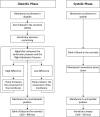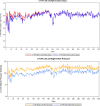First Clinical Experience With the Pressure Sensor-Based Autoregulation of Blood Flow in an Artificial Heart
- PMID: 34138778
- PMCID: PMC8478302
- DOI: 10.1097/MAT.0000000000001485
First Clinical Experience With the Pressure Sensor-Based Autoregulation of Blood Flow in an Artificial Heart
Abstract
The CARMAT-Total Artificial Heart (C-TAH) is designed to provide heart replacement therapy for patients with end-stage biventricular failure. This report details the reliability and efficacy of the autoregulation device control mechanism (auto-mode), designed to mimic normal physiologic responses to changing patient needs. Hemodynamic data from a continuous cohort of 10 patients implanted with the device, recorded over 1,842 support days in auto-mode, were analyzed with respect to daily changing physiologic needs. The C-TAH uses embedded pressure sensors to regulate the pump output. Right and left ventricular outputs are automatically balanced. The operator sets target values and the inbuilt algorithm adjusts the stroke volume and beat rate, and hence cardiac output, automatically. Auto-mode is set perioperatively after initial postcardiopulmonary bypass hemodynamic stabilization. All patients showed a range of average inflow pressures of between 5 and 20 mm Hg during their daily activities, resulting in cardiac output responses of between 4.3 and 7.3 L/min. Operator adjustments were cumulatively only required on 20 occasions. This report demonstrates that the C-TAH auto-mode effectively produces appropriate physiologic responses reflective of changing patients' daily needs and represents one of the unique characteristics of this device in providing almost physiologic heart replacement therapy.
Copyright © ASAIO 2021.
Conflict of interest statement
Disclosure: Dr. Netuka reports grants, personal fees, and nonfinancial support from Carmat SA, during the conduct of the study; grants, personal fees and nonfinancial support from Carmat SA, grants, personal fees and nonfinancial support from Abbott Int., nonfinancial support and other from LeviticusCardio Ltd., personal fees and nonfinancial support from Evaheart Inc., outside the submitted work. Dr. Poitier reports personal fees from Carmat, during the conduct of the study; personal fees from Carmat, outside the submitted work. Dr. Ivak reports personal fees and nonfinancial support from CARMAT, during the conduct of the study; grants, personal fees and nonfinancial support from Abbott, grants from Ministry of Health of Czech Republic, outside the submitted work. Dr. Konarik reports personal fees and nonfinancial support from CARMAT during the conduct of the study; grants and nonfinancial support from Abbott, grants from Ministry of Health of Czech Republic outside the submitted work. Perlès and Bousquet report being employed by Carmat SA, during the conduct of the study. Dr. Riha reports grants from Carmat SAS, during the conduct of the study; personal fees from Abbott, outside the submitted work. Dr. Latrémouille reports to be a Carmat consultant during the conduct of the study. Dr. Jansen reports being employed by Carmat SA, during the conduct of the study. The other authors have no conflicts of interest to report.
Figures







Comment in
-
CARMAT Total Artificial Heart and the Quest to Improve Biventricular Mechanical Support.ASAIO J. 2021 Oct 1;67(10):1109-1110. doi: 10.1097/MAT.0000000000001579. ASAIO J. 2021. PMID: 34529599 No abstract available.
References
-
- Carpentier A, Latrémouille C, Cholley B, et al. : First clinical use of a bioprosthetic total artificial heart: Report of two cases. Lancet 2015.386: 1556–1563. - PubMed
-
- Smadja DM, Susen S, Rauch A, et al. : The carmat bioprosthetic total artificial heart is associated with early hemostatic recovery and no acquired von Willebrand syndrome in calves. J Cardiothorac Vasc Anesth 2017.31: 1595–1602. - PubMed
-
- Bizouarn P, Roussel JC, Trochu JN, Perlès JC, Latrémouille C: Effects of pre-load variations on hemodynamic parameters with a pulsatile autoregulated artificial heart during the early post-operative period. J Heart Lung Transplant 2018.37: 161–163. - PubMed
-
- Canada JM, Evans RK, Abbate A, et al. : Exercise capacity in patients with the total artificial heart. ASAIO J 2018.65: 36–42. - PubMed
-
- Lavee J, Mulzer J, Krabatsch T, et al. : An international multicenter experience of biventricular support with HeartMate 3 ventricular assist systems. J Heart Lung Transplant 2018.37: 1399–1402. - PubMed
Publication types
MeSH terms
LinkOut - more resources
Full Text Sources
Medical

